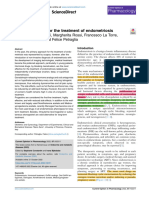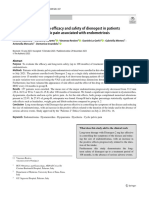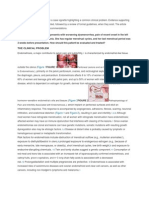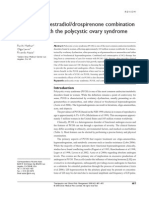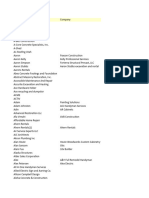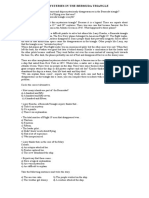Medical Treatment of Endometriosis: Review Article
Medical Treatment of Endometriosis: Review Article
Uploaded by
Aris MunandarCopyright:
Available Formats
Medical Treatment of Endometriosis: Review Article
Medical Treatment of Endometriosis: Review Article
Uploaded by
Aris MunandarOriginal Title
Copyright
Available Formats
Share this document
Did you find this document useful?
Is this content inappropriate?
Copyright:
Available Formats
Medical Treatment of Endometriosis: Review Article
Medical Treatment of Endometriosis: Review Article
Uploaded by
Aris MunandarCopyright:
Available Formats
Review Article
431
Medical Treatment of Endometriosis
Hong-Yuan Huang, MD
Endometriosis is a common, benign and chronic gynecological disorder. It is also an estrogen-dependent disorder that can result in substantial morbidity, including pelvic pain, progressive dysmenorrhea, dyspareunia, infertility and repeat surgeries. Endometriosis is often treated surgically upon diagnosis but with a higher rate of recurrence, suggesting that a combination of surgical and medical management might provide better outcomes. The primary goal of medical treatment for endometriosis is to halt the growth and activity of endometriosis lesions. The most widely utilized medical treatment for endometriosis involves use of gonadotropin-releasing hormone (GnRH) agonists and oral contraceptives. Conventional agents also include androgen derivates and progDr. Hong-Yuan Huang estins. Due to the chronic nature of this disease, long-term or repeated courses of medication may be required to control its related symptoms. Increasing knowledge about the pathogenesis of endometriosis at the cellular and molecular levels may give us the opportunity to use new, specific agents for treatment, including aromatase inhibitors, progesterone antagonists, selective progesterone receptor modulators, GnRH antagonists, intrauterine releasing systems with progestin and new pharmaceutical agents affecting inflammation, angiogenesis, and matrix metalloproteinase activity. Many of these promising new agents may prevent or inhibit the development of endometriosis. Further clinical trials may determine if these new therapies are superior to current medical treatment strategies for endometriosis. (Chang Gung Med J 2008;31:431-40) Key words: endometriosis, gonadotropin-releasing hormone, progestin, aromatase inhibitor
ndometriosis is a common, benign and chronic gynecological disorder. It is also an estrogendependent disorder that can result in substantial morbidity, including pelvic pain, infertility and multiple operations. It is characterized by the presence of uterine ectopic endometrial tissue outside of the uterine cavity-mainly on the pelvic peritoneum, but also on the ovaries and in the recto-vaginal septum, and
more rarely in the pericardium, pleura, and urinary tract. The prevalence of pelvic endometriosis approaches 6-10% in the general female population. The frequency of disease is increased to 35-50% in women with pelvic pain and infertility.(1-4) Despite its high prevalence and its recognition for most of the past century as an important cause of infertility and pelvic pain, its underlying mechanisms and patho-
From the Department of Obstetrics and Gynecology, Chang Gung Memorial Hospital, Taipei, Chang Gung University College of Medicine, Taoyuan, Taiwan. Received: Jun. 29, 2007; Accepted: Jan. 3, 2008 Correspondence to: Dr. Hong-Yuan Huang, Department of Obstetrics and Gynecology, Chang Gung Memorial Hospital. No. 5, Fusing St., Gueishan Township, Taoyuan County 333, Taiwan (R.O.C.) Tel.: 886-3-3281200 ext. 8251; Fax: 886-3-3288252; E-mail: hongyuan@cgmh.org.tw
Hong-Yuan Huang Medical treatment in endometriosis
432
physiology still are poorly understood. No single theory can explain the pathophysiology of all endometriosis.(5) The standard diagnosis of endometriosis is surgical assessment by laparoscopy or laparotomy. A scoring system has been developed and revised to assess the extent of disease.(6,7) For women with pain and with extensive adhesions, conservative surgery commonly provides temporary relief, although symptoms may occur again in most women within two years and further surgery is needed in these cases. (8,9) Because endometriosis is an estrogendependent disease, standard medical treatments aim at inducing hypoestrogenism and then inducing atrophy of ectopic endometrial implants. Medical hormone therapies historically have included oral contraceptives, progestins, and gonadotropin releasing hormone (GnRH) analogues, as well as androgen derivatives, and these have all been used successfully in the treatment of endometriosis.(10-13) All of these treatment modalities can be used only for a limited time owing to unacceptable side effects, including climacteric syndrome and loss of bone density. In addition, almost all of these treatment modalities fail to treat endometriosis-associated chronic pelvic pain and these drugs cannot cure the disease. At the present time, GnRH analogues are the most common medical therapy for endometriosis.(14,15) They dramatiTable 1. Summary of Medical Treatments for Endometriosis Agents Conventional medical treatments Oral contraceptives Mechanism
cally reduce the estrogenic pattern in patients with endometriosis but the effects of GnRH analogues are temporary because endometriosis foci cause problems again at the resumption of menstruation after cessation of treatment. However, our understanding of the pathogenesis of endometriosis at the cellular and molecular levels has improved significantly in recent years. Novel therapeutic strategies may improve our ability to eliminate endometriosis lesions which are already present and to prevent the recurrence of endometriosis and the multiple operations after initial surgical treatment.(16) This review focuses on standard medical treatment with conventional and new modalities in the medical treatment of endometriosis and its related clinical symptoms (Table 1).
Conventional medical treatments
The primary goal of medical treatment for endometriosis is to halt the growth and activity of endometriosis lesions. Conventional medications used to achieve this goal include androgen derivates, progestogens, oral contraceptive pills and GnRH agonists.(17-19) Conventional treatment approaches for the medical management of endometriosis usually are carried out in patients with suspected endometriosis, in those with a confirmed diagnosis of endometriosis, in those who have had surgical
Effect
References
decidualization and subsequent atrophy of endometrial tissue
Symptom relief
17, 21
GnRH agonists
down -regulation of the pituitary-ovary axis and hypoestrogenism
Symptom relief and decreased disease Symptom relief Symptom relief Decreased disease Decreased disease Symptom relief
41
Androgens Aromatase inhibitors GnRH antagonists Progesterone antagonists Selective progesterone receptor modulators
hyperandrogenism, inhibit steroidogenesis inhibit estrogen synthesis GnRH receptor blockade anti-progesterone suppress estrogen-dependent endometrial growth
26 53, 54 59 66, 67 71
Levonorgestrel-releasing intrauterine system
decidualization and subsequent atrophy of endometrial tissue
Symptom relief
74, 76
Chang Gung Med J Vol. 31 No. 5 September-October 2008
433
Hong-Yuan Huang Medical treatment in endometriosis
treatment of endometriosis and in those who need long-term management. The most widely utilized hormonal treatments for endometriosis are GnRH agonists, oral contraceptives and the androgen, danazol. The majority of evidence in support of medical therapy for endometriosis is largely observational, with the exception of studies of GnRH agonists, danazol, and a few progestins.(20) The advantage of an oral contraceptive over other hormonal treatments is that it can be taken indefinitely. An earlier study demonstrated that oral contraceptives were more effective in treating dysmenorrhea than GnRH agonists in fifty-seven patients with endometriosis. At the end of the six month follow-up, these patients did report a reduction in dysmenorrhea.(17) A further randomized study of ninety patients with recurrent moderate or severe pelvic pain after conservative surgery for symptomatic endometriosis demonstrated that oral contraceptives had the same efficacy and safety as cyproterone acetate in the treatment of endometriosis-associated recurrent pelvic pain.(21) According to an intention-to-treat analysis, 73% of patients (33 of 45) in the cyproterone acetate group and 67% (30 of 45) in the oral contraceptive group were satisfied with the treatment received in this study. Due to the chronic nature of the disease, long-term or repeated courses of medication may be required to control related symptoms. If oral contraceptives could be shown to be at least as effective as danazol or GnRH agonists, treatment options for long-term management of the disease could be broadened.(20,22) Androgens can induce a hyperandrogenic state and induce atrophy of the endometrium, which is the rationale for their use in the treatment of endometriosis. Danazol, a synthetic isoxazole derivative chemically related to 17-ethinyltestosterone, acts to increase the concentration of free testosterone by binding to sex-hormone-binding globulin and inhibits luteinizing hormone (LH) surge and steroid hormone production from the ovaries, resulting in a hypoestrogenic state.(23) All of this contributes to an inhibition of eutopic and ectopic endometrial growth. Multiple nonrandomized trials showed that the use of danazol resulted in an improvement in pain associated with endometriosis, in 66% to 100% of the women evaluated.(24-26) Common side effects related to hyperandrogenism which distress patients include
hirsutism, acne, and a raspy voice. The majority of these patients refuse to be treated with danazol because of its potential androgenic side effects.(27) Alternate routes of danazol administration are under investigation.(28-30) Many clinical trials have also compared the efficacy of danazol with that of the GnRH agonists. Both danazol and GnRH agonists showed the same efficacy in reducing both the growth of endometriotic implants and endometriosis-related symptoms during the treatment phases of the trial.(31-33) The obvious difference between them has been the profile of the side effects: the agonist has side effects associated more with a hypoestrogenic state and danazol more with an androgenic state, including weight gain, breast atrophy, hot flashes, and hirsutism.(34) The role of GnRH agonists in reproductive medicine as well as in the treatment of prostate cancer, precocious puberty, endometriosis, and uterine fibroids has been fully demonstrated.(35-38) GnRH when administered in a pulsatile fashion binds to the pituitary receptors and activates the gonadotrophs to both synthesize and release LH and follicle stimulating hormone (FSH). Paradoxically, GnRH agonists are modified forms of GnRH that bind to receptors in the pituitary, but have a longer half life than native GnRH and thereby result in down regulation of the pituitary-ovarian axis and hypoestrogenism.(39) GnRH agonists can be administered via a calibrated nasal spray, or by injection of either a shortacting formulation daily or of a depot formulation every one to three months. Side effects include hot flashes, vaginal dryness, decreased libido, mood swings, headache, and bone mineral depletion.(40) A long-term follow-up study of patients treated with a GnRH agonist alone for six months revealed a 53% recurrence of disease/symptoms two years after treatment.(41)
Aromatase inhibitors
It is well known that endometriosis is an estrogen-dependent disease and that this disorder tends to regress after estrogen deficiency. According to the two-cell two-gonadotropin theory, LH is capable of stimulating androgen substrate production from theca cells, to be transformed into estrogen by FSHstimulated aromatase activity in granulose cells.(42) In the human, aromatase activity is expressed in several types of cells in the reproductive system including
Chang Gung Med J Vol. 31 No. 5 September-October 2008
Hong-Yuan Huang Medical treatment in endometriosis
434
the ovarian granulosa cell, the placental syncytiotrophoblasts and the testicular Leydig cells. (43) Aromatase is the enzyme that represents the critical step in estrogen biosynthesis. It catalyzes the conversion of C19 steroids to estrogens (estrone and estradiol). (44) Therefore, there are no important downstream enzymes to be affected, with the result that aromatase is an excellent target for inhibition of estradiol synthesis. In addition, because estrogen is needed to stimulate ectopic endometriotic tissues in patients with endometriosis and the because of the in situ presence of aromatase in these tissues, blockage of aromatase activity in these endometriotic sites with an aromatase inhibitor is a rational approach to medical treatment of endometriosis.(45,46) The aromatase inhibitors are classified into type I and type II inhibitors. Both types of inhibitors compete for binding to the active site. Enzyme activity is then permanently blocked due to an unbreakable bond between the inhibitor and enzyme protein.(47-49) Several potent and selective third-generation aromatase inhibitors are available; of these, anastrozole and letrozole have substantial advantages over earlier agents in terms of efficacy and tolerability. (50) Although these agents have been widely used to treat postmenopausal or anovulatory patients with breast cancer, clinical experience with aromatase inhibitors in women with endometriosis is still limited.(51) A nonrandomized pilot study demonstrated that a combination of letrozole (2.5 mg/day) and norethindrone acetate for 6 months is effective in both reducing laparoscopically visible endometriotic lesions and decreasing pelvic pain scores.(52) In another representative study, two premenopausal sisters (24 and 26 years old) were diagnosed with endometriosis by laparoscopy and failed to respond to conventional treatment including oral contraceptives and GnRH analogues. An aromatase inhibitor (anastrozole 1 mg/day) was given with progestin (200 mg/day) for 6 months. The treatment resulted in a rapid progressive reduction in symptoms with the maintenance of remission of symptoms and absence of endometriotic lesions for more than two years after treatment in both cases. Pregnancy was achieved in both cases after two years. Side effects were minimal and well tolerated by both patients.(53) Recently, a prospective, randomized trial showed that 6 months of treatment with anastrozole (1 mg/day) and goserelin compared with goserelin alone increased the pain-free interval
and decreased symptom recurrence rates in patients after surgery for severe endometriosis. Interestingly, the authors suggested that the efficacy of the protocol might be the result of the fact that goserelin inhibits ovarian steroidogenesis and anastrozole inhibits the consequences of peripheral aromatization and aberrant expression of aromatase in the endometriotic foci.(54) In conclusion, patients with endometriosis who do not respond to existing treatments appear to obtain significant pain relief with aromatase inhibitors. Regimens which include combinations of an aromatase inhibitor with a progestin or oral contraceptive will probably become more popular than combinations of an aromatase inhibitor with a GnRH analogue because the former are cheaper with fewer side effects, and may be administered long term or for repeated courses.(55)
GnRH antagonists
Selective blockade of gonadotropin secretion and suppression of ovarian steroid production have previously been achieved by down - regulation of the pituitary gland to continuously administer by giving long-acting GnRH agonists. Recently, GnRH antagonists that immediately block GnRH effects have been developed for clinical use in endometriosis, leiomyoma, and breast cancer in women, benign prostate hypertrophy and prostate carcinoma in men, and precocious puberty in children.(56) The antagonistic properties of GnRH exert their effect by competing with endogenous GnRH for pituitary binding sites. A more rapid suppression of gonadotropin release from the pituitary gland can be achieved, in comparison with that of agonists, enabling shorter treatment regimes in ovarian hyperstimulation for assisted reproduction.(57) GnRH antagonists are not like agonists, which cause flare-up stimulation of gonadotropin and ovarian steroid hormone release. Therefore, they have the theoretical advantage of working faster and more effectively than GnRH agonists with an earlier improvement of symptoms. A representative study demonstrated that subcutaneous injection of the GnRH antagonists significantly reduces the size of endometriotic lesions in a dosedependent manner in a rat model.(58) A pilot study reported a total of fifteen women who received a treatment protocol with 3 mg of cetrorelix (Cetrotide) weekly for eight weeks. All patients
Chang Gung Med J Vol. 31 No. 5 September-October 2008
435
Hong-Yuan Huang Medical treatment in endometriosis
reported a symptom-free period during GnRH antagonist treatment. Regression occurred in more than half of the cases and the degree of endometriosis declined to a mild stage on second look laparoscopy. Preserving basic estrogen production during the course of GnRH antagonist treatment apparently does not influence regression of disease, and has no major side effects.(59) GnRH antagonists seem to be useful in the treatment of endometriosis in most cases. Furthermore, fewer side effects, such as postmenopausal symptoms, occur with this agent and no estradiol add-back is needed. In the future, new nonpeptic GnRH antagonists are expected to be available for oral administration. Although they are still under investigation, these agents have the potential to improve patients comfort and compliance.(60)
Mifepristone (progesterone antagonist)
Selective progesterone receptor modulators (SPRM)
Mifepristone (RU 486) is an oral active progesterone antagonist at the receptor level. It also has a high affinity for progesterone and glucocorticoid II receptors. With its antiprogesterone effect, mifepristone prevents progesterone from exerting its action. It also has a direct inhibitory effect on human endometrial cells(61) and it can modulate the estrogen and progesterone receptor expression in both eutopic and ectopic endometrium.(62) In addition, mifepristone is effective in decreasing the size of endometriotic implants in a primate model.(63) Kettel et al published a series of studies of administration of different doses of mifepristone in women with endometriosis. (64-66) A minimum dose of 50 mg mifepristone for six months demonstrated a significant regression in visible endometriotic lesions and a decrease in clinical symptoms. On the other hand, treatment of endometriosis patients with mifepristone 5 mg per day in an uncontrolled pilot study resulted in pain improvement but no change in endometriosis lesions, suggesting this dosage is too low to achieve acceptable efficacy.(67) There is concern about the safety of long- term treatment because of the antiglucocorticoid properties of mifepristone. Hypoadrenalism must be considered as a major side effect of long-term treatment, especially with e doses over 200 mg per day.(16) Further large randomized clinical trials on the use of mifepristone in women with endometriosis should be performed in the future.
SPRM are novel progesterone receptor ligands with a high degree of endometrial selectivity that exhibit agonist/antagonist effects in vivo based on the target tissue.(68) They have the potential to induce reversible amenorrhea through selective inhibition of endometrial proliferation, a direct effect on endometrial blood vessels and the potential to suppress endometrial prostaglandin production in a tissue-specific manner without the systemic effects of estrogen deprivation, providing a rationale for the treatment of endometriosis -related pain.(69) Asoprisnil is the first SPRM to reach an advanced stage of clinical development for the treatment of endometriosis. Asoprisnil can suppress both the menstrual cycle and endometrial growth.(70) To date, only one randomized, placebo-controlled, dose-finding phase II study of asoprisnil has been conducted in subjects with pain from endometriosis.(71) One hundred thirty patients with a laparoscopic diagnosis of endometriosis were treated with asoprisnil (5, 10, and 25 mg) for twelve weeks. All three asoprisnil doses significantly reduced the dysmenorrhea from endometriosis in comparison with a placebo. A separate study with an identical design using different asoprisnil doses showed that 5 mg is the minimum effective dose for pain relief in subjects with endometriosis.(72) Both studies also confirmed favorable safety and tolerability profiles of asoprisnil during short-term treatment. No serious, drug-related adverse events were reported during the treatment or follow-up period.
Levonorgestrel-releasing intrauterine system
Levonorgestrel is a potent steroid widely used in oral contraceptives and subdermally implanted contraceptive devices. It is a T-shaped intrauterine system which after insertion releases the hormone levonorgestrel into the womb. The use of the intrauterine releasing system with levonorgestrel has revealed some additional health benefits other than contraception, including treatment of menorrhagia and inhibition of endometrium proliferation during postmenopausal estrogen therapy. The release rate of levonorgestrel from the intrauterine releasing system is 20 g per 24 hours during the first year, and it slowly decreases throughout the 5 years of use, inducing the endometrium to become atrophic and inactive. (73) Because of this profound effect on the endometrium,
Chang Gung Med J Vol. 31 No. 5 September-October 2008
Hong-Yuan Huang Medical treatment in endometriosis
436
this device is an alternative in the medical treatment of women suffering from endometriosis, adenomyosis, chronic pelvic pain, and dysmenorrhea, as well as menorrhagia. For women with endometriosis who need long-term treatment, the levonorgestrelreleasing intrauterine system may be a treatment of choice since it permits the same system to be used for at least 5 years with no modifications in estrogen levels and few hypoestrogenic side effects.(74-76)
Future development of new drugs for endometriosis
compare the effectiveness of these drugs with current modalities in the medical treatment of patients with endometriosis.
REFERENCES
1. Houston DE, Noller KL, Melton LJ, Selwyn BJ. The epidemiology of pelvic endometriosis. Clin Obstet Gynecol 1988;31:787-800. 2. Cramer DW, Missmer SA. The epidemiology of endometriosis. Ann N Y Acad Sci 2002;955:11-22. 3. Sensky TE, Liu DT. Endometriosis: associations with menorrhagia, infertility and oral contraceptives. Int J Gynaecol Obstet 1980;17:573-6. 4. Eskenazi B, Warner ML. Epidemiology of endometriosis. Obstet Gynecol Clin North Am 1997;24:235-58. 5. Crosignani P, Olive D, Bergqvist A, Luciano A. Advances in the management of endometriosis: an update for clinicians. Hum Reprod Update 2006;12:179-89. 6. American Fertility Society. Classification of endometriosis. Fertil Steril 1979;32:633-45. 7. American Fertility Society. Revised American Fertility Society Classification of endometriosis. Fertil Steril 1985;43:351-2. 8. Kuohung W, Jones GL, Vitonis AF, Cramer DW, Kennedy SH, Thomas D, Hornstein MD. Characteristics of patients with endometriosis in the United States and the United Kingdom. Fertil Steril 2002;78:767-72. 9. Candiani GB, Fedele L, Vercellini P, Bianchi S, DiNola G. Repetitive conservative surgery for recurrence of endometriosis. Obstet Gynecol 1991;77:421-4. 10. Practice Committee of the American Society for Reproductive Medicine. Endometriosis and infertility. Fertil Steril 2004;81:1441-6. 11. Olive DL, Lindheim SR, Pritts EA. New medical treatments for endometriosis. Best Pract Res Clin Obstet Gynaecol 2004;18:319-28. 12. Lessey BA. Medical management of endometriosis and infertility. Fertil Steril 2000;73:1089-96. 13. Valle RF, Sciarra JJ. Endometriosis: treatment strategies. Ann N Y Acad Sci 2003;997:229-39. 14. Wheeler JM, Knittle JD, Miller JD. Depot leuprolide versus danazol in treatment of women with symptomatic endometriosis. I. Efficacy results. Am J Obstet Gynecol 1992;167:1367-71. 15. Rock JA, Truglia JA, Caplan RJ. Zoladex (goserelin acetate implant) in the treatment of endometriosis: a randomized comparison with danazol. The Zoladex Endometriosis Study Group. Obstet Gynecol 1993;82:198-205. 16. Ferrero S, Abbamonte LH, Anserini P, Remorgida V, Ragni N. Future perspectives in medical treatment of endometriosis. Obstet Gynecol Surv 2005;60:817-26. 17. Vercellini P, Trespidi L, Colombo A. A gonadotropinreleasing hormone agonist versus a low-dose oral contra-
Medical treatment options for endometriosis currently under investigation include immunomodulating drugs (pentoxifylline and loxoribine) that inhibit the effect of tumor necrosis factor (TNF)-, matrix metalloproteinase (MMP), and angiogenesis.(23) Therapeutic manipulation of the immune system through TNF- inhibitors may be beneficial in women with endometriosis.(77) The MMPs are a family of endopeptidases that are capable of degrading components of the extracellular matrix. It is important to many physiological and pathological processes, including embryo implantation, cyclic endometrial breakdown and endometriosis, and is regulated by its natural occurring inhibitor, tissue inhibitors of matrix metalloproteinase (TIMPs).(78,79) Suppressing the action of secreted MMPs from human ectopic endometrium with TIMP-1significantly inhibited the establishment of endometriosis lesions in a nude mice model.(80) Several cytokines may also play a role in the treatment of endometriosis. A major function of interleukin-12 (IL-12) and IL-18 is the regulation of the adaptive immune response. (81) IL-12 induces other cytokines, particularly interferon- (IFN-), which coordinate the ensuing immune response. Intraperitoneal injection of IL-12 in a murine model of endometriosis demonstrated a significant reduction of ectopic endometrial implantation.(82)
Conclusion
A better understanding of the molecular mechanism of endometriosis will result in innovative new treatments in the future. Many of these promising new agents are currently in clinical trials to evaluate efficacy and side effects, and subsequently may better reproductive outcomes. Therefore prospective, randomized clinical trials will then be needed to
Chang Gung Med J Vol. 31 No. 5 September-October 2008
437
Hong-Yuan Huang Medical treatment in endometriosis
18.
19.
20. 21.
22. 23. 24.
25.
26.
27.
28.
29.
30.
31.
32.
33.
ceptive for pelvic pain associated with endometriosis. Fertil Steril 1993;60:75-9. Waller KG, Shaw RW. Gonadotropin-releasing hormone analogues for the treatment of endometriosis: long-term follow-up. Fertil Steril 1993;59:511-5. Vercellini P, Trespidi L, DeGiorgi O, Cortesi I, Parazzini F, Crosignani PG. Endometriosis and pelvic pain. Relation to disease stage and localization. Fertil Steril 1996;65:299-304. Rice VM. Conventional medical therapies for endometriosis. Ann N Y Acad Sci 2002;955:343-52. Vercellini P, De Giorgi O, Mosconi P, Stellato G, Vicentini S, Crosignani PG. Cyproterone acetate versus a continuous monophasic oral contraceptive in the treatment of recurrent pelvic pain after conservative surgery for symptomatic endometriosis. Fertil Steril 2002;77:5261. Hompes PG, Mijatovic V. Endometriosis: the way forward. Gynecol Endocrinol 2007;23:5-12. Olive DL. Medical therapy of endometriosis. Semin Reprod Med 2003;21:209-22. Oral E, Arici A. Peritoneal growth factors and endometriosis. Semin Reprod Endocrinol 1996;14:25767. Dmowski WP, Cohen MR. Treatment of endometriosis with an antigonadotropin, danazol: A laparoscopic and histologic evaluation. Obstet Gynecol 1975;46:147-54. Buttram VC, Reiter RC, Ward S. Treatment of endometriosis with danazol: report of a 6-year prospective study. Fertil Steril 1985;43:353-60. Kauppila A. Changing concepts of medical treatment of endometriosis. Acta Obstet Gynecol Scand 1993;72:32436. Mizutani T, Nishiyama S, Amakawa I, Watanabe A, Nakamuro K, Terada N. Danazol concentrations in ovary, uterus, and serum and their effect on the hypothalamicpituitary-ovarian axis during vaginal administration of a danazol suppository. Fertil Steril 1995;63:1184-9. Igarashi M, Iizuka M, Abe Y, Ibuki Y. Novel vaginal danazol ring therapy for pelvic endometriosis, in particular deeply infiltrating endometriosis. Hum Reprod 1998;13:1952-6. Cobellis L, Razzi S, Fava A, Severi FM, Igarashi M, Petraglia F. A danazol-loaded intrauterine device decreases dysmenorrhea, pelvic pain, and dyspareunia associated with endometriosis. Fertil Steril 2004;82:239-40. Henzl MR, Corson SL, Moghissi K, Buttram VC, Berqvist C, Jacobson J. Administration of nasal nafarelin as compared with oral danazol for endometriosis. A multicenter double-blind comparative clinical trial. N Engl J Med 1988;318:485-9. Kennedy SH, Williams IA, Brodribb J, Barlow DH, Shaw RW. A comparison of nafarelin acetate and danazol in the treatment of endometriosis. Fertil Steril 1990;53:9981003. The Nafarelin European Endometriosis Trial Group
34.
35.
36.
37.
38.
39.
40.
41.
42.
43.
44.
45.
46.
(NEET). Nafarelin for endometriosis: a large-scale, danazol-controlled trial of efficacy and safety, with 1-year follow-up. Fertil Steril 1992;57:514-22. Barbieri RL, Evans S, Kistner RW. Danazol in the treatment of endometriosis: analysis of 100 cases with a 4year follow-up. Fertil Steril 1982;37:737-46. Pellicer A, Simon C, Miro F, Castellvi RM, Ruiz A, Ruiz M, Perez M, Bonilla-Musoles F. Ovarian response and outcome of in-vitro fertilization in patients treated with gonadotropin-releasing hormone analogues in different phases of the menstrual cycle. Hum Reprod 1989;4:285-9. Pellicer A, Tarin JJ, Miro F, Sampaio M, De los Santos MJ, Remohi J. The use of gonadotropin releasing-hormone analogues (GnRHa), in in-vitro fertilization: some clinical and experimental investigations of a direct effect on the human ovary. Hum Reprod 1992;7:39-47. Emons G, Schally AV. The use of luteinizing hormone releasing hormone agonists and antagonists in gynaecological cancers. Hum Reprod 1994;9:1364-79. Chegini N, Rong H, Dou Q, Kipersztok, Williams RS. Gonadotropin-releasing hormone (GnRH) and GnRH receptor gene expression in human myometrium and leiomiomata and the direct action of GnRH analogs on myometrial smooth muscle cells and interaction with ovarian steroids in vitro. J Clin Endocrinol Metab 1996;81:3215-22. Hsueh AJW, Jones PBC. Extrapituitary actions of gonadotropin releasing hormone. Endocr Rev 1981;2:43755. Sagsveen M, Farmer JE, Prentice A, Breeze A. Gonadotrophin-releasing hormone analogues for endometriosis: bone mineral density. Cochrane Database Syst Rev 2003;4:CD001297. Waller KG, Shaw RW. Gonadotropin-releasing hormone analogues for the treatment of endometriosis: long-term follow-up. Fertil Steril 1993;59:511-5. Greep RO, Van Dyke HB, Chow BF. Gonadotropin of swine pituitary: various biological effects of purified thylkentrin (FSH) and pure matakentrin (ICSH). Endocrinology 1942;30:635-49. Simpson ER, Mahendroo MS, Means GD, Kilgore MW, Hinshelwood MM, Graham-Lorence S, Amarneh B, Ito Y, Fisher CR, Michael MD. Aromatase cytochrome P450, the enzyme responsible for estrogen biosynthesis. Endocr Rev 1994;15:342-55. Simpson ER, Clyne C, Rubin G, Boon WC, Robertson K, Britt K, Speed C, Jones M. Aromatase-a brief overview. Annu Rev Physiol 2002;64:93-127. Bulun SE, Zeitoun K, Takayama K, Noble L, Michael D, Simpson E, Johns A, Putman M, Sasano H. Estrogen production in endometriosis and use of aromatase inhibitors to treat endometriosis. Endocr Relat Cancer 1999;6:293301. Zeitoun KM, Bulun SE. Aromatase: a key molecule in the pathophysiology of endometriosis and a therapeutic target. Fertil Steril 1999;72:961-9.
Chang Gung Med J Vol. 31 No. 5 September-October 2008
Hong-Yuan Huang Medical treatment in endometriosis
438
47. Buzdar A, Howell A. Advances in aromatase inhibition: clinical efficacy and tolerability in the treatment of breast cancer. Clin Cancer Res 2001;7:2620-35. 48. Goss PE, Strasser K. Aromatase inhibitors in the treatment and prevention of breast cancer. J Clin Oncol 2001;19:881-94. 49. Buzdar AU, Robertson JF, Eiermann W, Nabholtz JM. An overview of the pharmacology and pharmacokinetics of the newer generation aromatase inhibitors anastrozole, letrozole, and exemestane. Cancer 2002;95:2006-16. 50. Santen RJ, Harvey HA. Use of aromatase inhibitors in breast carcinoma. Endocr Relat Cancer 1999;6:75-92. 51. Oktay K, Hourvitz A, Sahin G, Oktem O, Safro B, Cil A, Bang H. Letrozole reduces estrogen and gonadotropin exposure in women with breast cancer undergoing ovarian stimulation before chemotherapy. J Clin Endocrinol Metab 2006;91:3885-90. 52. Ailawadi RK, Jobanputra S, Kataria M, Gurates B, Bulun SE. Treatment of endometriosis and chronic pelvic pain with letrozole and norethindrone acetate: a pilot study. Fertil Steril 2004;81:290-6. 53. Shippen ER, West WJ Jr. Successful treatment of severe endometriosis in two premenopausal women with an aromatase inhibitor. Fertil Steril 2004;81:1395-8. 54. Soysal S, Soysal ME, Ozer S, Gul N, Gezgin T. The effects of post-surgical administration of goserelin plus anastrozole compared to goserelin alone in patients with severe endometriosis: a prospective randomized trial. Hum Reprod 2004;19:160-7. 55. Attar E, Bulun SE. Aromatase inhibitors: the next generation of therapeutics for endometriosis? Fertil Steril 2006;85:1307-18. 56. Huirne JA, Lambalk CB. Gonadotropin-releasing-hormone-receptor antagonists. Lancet 2001;358:1793-803. 57. Griesinger G, Felberbaum R, Diedrich K. GnRH-antagonists in reproductive medicine. Arch Gynecol Obstet 2005;273:71-8. 58. Jones RC. The effect of a luteinizing hormone-releasing hormone antagonist on experimental endometriosis in the rat. Acta Endocrinol 1987;114:379-82. 59. Kupker W, Felberbaum RE, Krapp M, Schill T, Malik E, Diedrich K. Use of GnRH antagonists in the treatment of endometriosis. Reprod Biomed Online 2002;5:12-6. 60. Finas D, Hornung D, Diedrich K, Schultze-Mosgau A. Cetrorelix in the treatment of female infertility and endometriosis. Expert Opin Pharmacother 2006;7:215568. 61. Murphy AA, Zhou MH, Malkapuram S, Santanam N, Parthasarathy S, Sidell N. RU486-induced growth inhibition of human endometrial cells. Fertil Steril 2000;74:1014-9. 62. Jiang J, Wu RF, Wang ZH, Sun HC, Xu Z, Xiu HM. Effect of mifepristone on estrogen and progesterone receptors in human endometrial and endometriotic cells in vitro. Fertil Steril 2002;77:995-1000. 63. Grow DR, Williams RF, Hsiu JG, Hodgen GD.
64.
65.
66.
67.
68.
69.
70.
71.
72.
73.
74.
75.
76.
Antiprogestin and/or gonadotropin-releasing hormone agonist for endometriosis treatment and bone maintenance: a 1-year primate study. J Clin Endocrinol Metab 1996;81:1933-9. Kettel LM, Murphy AA, Mortola JF, Liu JH, Ulmann A, Yen SS. Endocrine responses to long-term administration of the antiprogesterone RU486 in patients with pelvic endometriosis. Fertil Steril 1991;56:402-7. Kettel LM, Murphy AA, Morales AJ, Yen SS. Clinical efficacy of the antiprogesterone RU486 in the treatment of endometriosis and uterine fibroids. Hum Reprod 1994;9(suppl 1):116-20. Kettel LM, Murphy AA, Morales AJ, Ulmann A, Baulieu EE, Yen SS. Treatment of endometriosis with the antiprogesterone mifepristone (RU486). Fertil Steril 1996;65:23-8. Kettel LM, Murphy AA, Morales AJ, Yen SS. Preliminary report on the treatment of endometriosis with low-dose mifepristone (RU 486). Am J Obstet Gynecol 1998;178:1151-6. Elger W, Bartley J, Schneider B, Kaufmann G, Schubert G, Chwalisz K. Endocrine pharmacological characterization of progesterone antagonists and progesterone receptor modulators with respect to PR-agonistic and antagonistic activity. Steroids 2000;65:713-23. Chwalisz K, Garg R, Brenner RM, Schubert G, Elger W. Selective progesterone receptor modulators (SPRMs): a novel therapeutic concept in endometriosis. Ann N Y Acad Sci 2002;955:373-88. DeManno D, Elger W, Garg R, Lee R, Schneider B, HessStumpp H, Schubert G, Chwalisz K. Asoprisnil (J867): a selective progesterone receptor modulator for gynecological therapy. Steroids 2003;68:1019-32. Chwalisz K, Mattia-Goldberg K, Lee M, Elger W, Edmonds A. Treatment of endometriosis with the novel selective progesterone receptor modulator (SPRM) asoprisnil. Fertil Steril 2004;82:S83-4. Chwalisz K, Perez MC, Demanno D, Winkel C, Schubert G, Elger W. Selective progesterone receptor modulator development and use in the treatment of leiomyomata and endometriosis. Endocr Rev 2005;26:423-38. Luukkainen T, Lahteenmaki P, Toivonen J. Levonorgestrel-releasing intrauterine device. Ann Med 1990;22:85-90. Lockhat, FB, Emembolu JO, Konje JC. The efficacy, sideeffects and continuation rates in women with symptomatic endometriosis undergoing treatment with an intra-uterine administered progestogen (levonorgestrel): a 3 year follow-up. Hum Reprod 2005;20:789-93. Bahamondes L, Petta CA, Fernandes A, Monteiro I. Use of the levonorgestrel-releasing intrauterine system in women with endometriosis, chronic pelvic pain and dysmenorrhea. Contraception 2007;75:S134-9. Petta CA, Ferriani RA, Abrao MS, Hassan D, Rosa E Silva JC, Podgaec S, Bahamondes L. Randomized clinical trial of a levonorgestrel-releasing intrauterine system and
Chang Gung Med J Vol. 31 No. 5 September-October 2008
439
Hong-Yuan Huang Medical treatment in endometriosis
a depot GnRH analogue for the treatment of chronic pelvic pain in women with endometriosis. Hum Reprod 2005;20:1993-8. 77. DAntonio M, Martelli F, Peano S, Papoian R, Borrelli F. Ability of recombinant human TNF binding protein-1 (rhTBP-1) to inhibit the development of experimentallyinduced endometriosis in rats. J Reprod Immunol 2000;48:81-98. 78. Huang HY, Wen Y, Irwin JC, Kruessel JS, Soong YK, Polan ML. Cytokine mediated regulation of 92-kilodalton type IV collagenase, tissue inhibitor of metalloproteinase1 (TIMP-1), and TIMP-3 messenger ribonucleic acid expression in human endometrial stromal cells. J Clin Endocrinol Metab 1998;83:1721-9. 79. Huang HY. The cytokine network during embryo implan-
tation. Chang Gung Med J 2006;29:25-36. 80. Bruner KL, Matrisian LM, Rodgers WH, Gorstein F, Osteen KG. Suppression of matrix metalloproteinases inhibits establishment of ectopic lesions by human endometrium in nude mice. J Clin Invest 1997;99:2851-7. 81. Huang HY, Chan SH, Yu HT, Wang HS, Lai CH, Soong YK. Interleukin-18 system messenger ribonucleic acid and protein expression in human endometrium during menstrual cycle. Fertil Steril 2006;86:905-13. 82. Somigliana E, Vigano P, Rossi G, Carinelli S, Vignali M, Panina-Bordignon P. Endometrial ability to implant in ectopic sites can be prevented by interleukin-12 in a murine model of endometriosis. Hum Reprod 1999;14:2944-50.
Chang Gung Med J Vol. 31 No. 5 September-October 2008
440
( 2008;31:431-40)
966299713 3335Tel.: (03)32812008251; Fax: (03)3288252; E-mail: hongyuan@cgmh.org.tw
You might also like
- Nat Geo Learning PDFDocument108 pagesNat Geo Learning PDFIpek özgen100% (5)
- COMM11: Purposive CommunicationDocument201 pagesCOMM11: Purposive CommunicationNiña Mae Lacno Into100% (1)
- Levi's 501 Integrated Marketing Strategy: Team 6 January 14, 2011Document26 pagesLevi's 501 Integrated Marketing Strategy: Team 6 January 14, 2011Shifra BhaviskarNo ratings yet
- Menu Engineering Chapter 1Document47 pagesMenu Engineering Chapter 1Rizkiy A. Fadlillah100% (2)
- Pharmacological Treatment of Endometriosis Update From Recent Clinical Trials PDFDocument9 pagesPharmacological Treatment of Endometriosis Update From Recent Clinical Trials PDFEffi KurniasihNo ratings yet
- 1 s2.0 S1471489222001382 MainDocument7 pages1 s2.0 S1471489222001382 MainDrelciuc MirunaNo ratings yet
- Efficacy and Safety of Long Term Treatment in EndometriosisDocument7 pagesEfficacy and Safety of Long Term Treatment in EndometriosisPt.Natasha AriviaNo ratings yet
- Treatment EndometriosisDocument18 pagesTreatment EndometriosisAnonymous vxyyUu0MlZNo ratings yet
- Review Article: Medical Treatments For Endometriosis-Associated Pelvic PainDocument12 pagesReview Article: Medical Treatments For Endometriosis-Associated Pelvic PainponekNo ratings yet
- Role of Medical Therapy in The Management of Uterine AdenomyosisDocument8 pagesRole of Medical Therapy in The Management of Uterine Adenomyosisdian_067No ratings yet
- Bedaiwy 2017Document11 pagesBedaiwy 2017Derevie Hendryan MoulinaNo ratings yet
- Reduce EndometriosisreccurenceDocument6 pagesReduce EndometriosisreccurencePt.Natasha AriviaNo ratings yet
- Evaluation of Long Term Efficacy and Safety of Dienogest in Patients With Chronic Cyclic Pelvic Pain Associated With EndometriosisDocument9 pagesEvaluation of Long Term Efficacy and Safety of Dienogest in Patients With Chronic Cyclic Pelvic Pain Associated With EndometriosisbanghirotadagantenkNo ratings yet
- Medical Treatment of Endometriosis-Related PainDocument24 pagesMedical Treatment of Endometriosis-Related PainAgung SentosaNo ratings yet
- Grandi 2019. Hormonal Contraception in Women With Endometriosis - A Systematic ReviewDocument11 pagesGrandi 2019. Hormonal Contraception in Women With Endometriosis - A Systematic ReviewcespersiNo ratings yet
- obat kistaDocument8 pagesobat kistadeboraekaseNo ratings yet
- Innovations in Conservative Endometriosis Treatment: An Updated ReviewDocument14 pagesInnovations in Conservative Endometriosis Treatment: An Updated ReviewparamitastellaNo ratings yet
- Treatment of Endometriosis-Associated Pain With Elagolix - NEJM 2017Document13 pagesTreatment of Endometriosis-Associated Pain With Elagolix - NEJM 2017Lenar AnthonyNo ratings yet
- Molecular Basis For Treating Endometriosis With Aromatase InhibitorsDocument6 pagesMolecular Basis For Treating Endometriosis With Aromatase InhibitorsneoaasNo ratings yet
- The LaparoscopicDocument13 pagesThe Laparoscopicevolucionmedica1208No ratings yet
- Drug Delivery For Treatment of EndometriosisDocument11 pagesDrug Delivery For Treatment of EndometriosisDEVYANI KADAMNo ratings yet
- Referat EndometriosisDocument18 pagesReferat EndometriosisAuliaNo ratings yet
- Endometriosis_ Treatment of Pelvic Pain - UpToDateDocument21 pagesEndometriosis_ Treatment of Pelvic Pain - UpToDatemedicinapapNo ratings yet
- PB 110Document13 pagesPB 110Mona HelouNo ratings yet
- MB6 OG LP 2 RoshilDocument5 pagesMB6 OG LP 2 RoshilRoshilNo ratings yet
- 2018 Article 1119Document8 pages2018 Article 1119ngocphuc190197No ratings yet
- Upl 04Document3 pagesUpl 04babekayyasaNo ratings yet
- Surgical Approach To Hysterectomy For Benign Gynaecological DiseaseDocument19 pagesSurgical Approach To Hysterectomy For Benign Gynaecological DiseasebambangtrionocNo ratings yet
- Clinical Efficacy and Safety of Trimonthly Administration of Goserelin Acetate 10.8 MG in Premenopausal Chinese Females With Symptomatic AdenomyosisDocument7 pagesClinical Efficacy and Safety of Trimonthly Administration of Goserelin Acetate 10.8 MG in Premenopausal Chinese Females With Symptomatic Adenomyosisabdulsamadk783No ratings yet
- J Ejogrb 2010 04 002Document6 pagesJ Ejogrb 2010 04 002ngocphuc190197No ratings yet
- Treating Endometriosis With The Integration of Traditional Chinese Medicine and Western MedicineDocument6 pagesTreating Endometriosis With The Integration of Traditional Chinese Medicine and Western MedicinedoeaNo ratings yet
- Vipos & EnvisioenDocument14 pagesVipos & EnvisioenPt.Natasha AriviaNo ratings yet
- Minimising Menopausal Side Effects WhilstDocument8 pagesMinimising Menopausal Side Effects WhilstUmaimah ShahabNo ratings yet
- Booklet 3Document19 pagesBooklet 3soumik.msdNo ratings yet
- Use of Dienogest in Endometriosis: A Narrative Literature Review and Expert CommentaryDocument13 pagesUse of Dienogest in Endometriosis: A Narrative Literature Review and Expert Commentaryngocphuc190197No ratings yet
- Ijwh 3 175 PDFDocument10 pagesIjwh 3 175 PDFstressedessertsNo ratings yet
- Study of Dienogest For Dysmenorrhea and Pelvic Pain Associated With EndometriosisDocument6 pagesStudy of Dienogest For Dysmenorrhea and Pelvic Pain Associated With Endometriosiskurnia fitriNo ratings yet
- Dismenorrhea3 PDFDocument5 pagesDismenorrhea3 PDFponekNo ratings yet
- Upl 05Document2 pagesUpl 05babekayyasaNo ratings yet
- Donnez Et Al (2020)Document12 pagesDonnez Et Al (2020)gd4f8dhkhhNo ratings yet
- Endmometriosis 1Document7 pagesEndmometriosis 1sabrinaanggrainiNo ratings yet
- Is It Value IVFDocument6 pagesIs It Value IVFamalia makmurNo ratings yet
- VIPOSDocument10 pagesVIPOSPt.Natasha AriviaNo ratings yet
- Use of Ethinylestradiol/drospirenone Combination in Patients With The Polycystic Ovary SyndromeDocument6 pagesUse of Ethinylestradiol/drospirenone Combination in Patients With The Polycystic Ovary SyndromeMonalisa SatpathyNo ratings yet
- Maternal Quiz 1Document59 pagesMaternal Quiz 1Teresa DumalagNo ratings yet
- Kjim 2021 216Document14 pagesKjim 2021 216reza MDNo ratings yet
- Use of Aromatase Inhibitors To Treat Endometriosis-Related Pain Symptoms: A Systematic ReviewDocument10 pagesUse of Aromatase Inhibitors To Treat Endometriosis-Related Pain Symptoms: A Systematic ReviewponekNo ratings yet
- Atención Médica: Medical CareDocument5 pagesAtención Médica: Medical CareDarwin PérezNo ratings yet
- Reproductive Pharmacology Lecturio ReflectionDocument7 pagesReproductive Pharmacology Lecturio ReflectionNathaniel SolisNo ratings yet
- GNRH Antagonist Linzagolix and Assisted Reproduction 1596988989 PDFDocument2 pagesGNRH Antagonist Linzagolix and Assisted Reproduction 1596988989 PDFIoana Adina RugescuNo ratings yet
- Medical Treatment For Uterine MyomasDocument6 pagesMedical Treatment For Uterine MyomasAyeshah RosdahNo ratings yet
- Пател Дхрувил Статья-1Document7 pagesПател Дхрувил Статья-1RAJ ParmarNo ratings yet
- Patogesis EndometriosisDocument39 pagesPatogesis EndometriosisponekNo ratings yet
- Ojog 2015031717082632Document6 pagesOjog 2015031717082632SarlitaIndahPermatasariNo ratings yet
- En Dome Trios IsDocument13 pagesEn Dome Trios IsJerome Diplomatic NugentNo ratings yet
- ENDOMETRIOSIS Panel Disscussion MarchDocument50 pagesENDOMETRIOSIS Panel Disscussion Marchbdeekshithgouda92No ratings yet
- MacyDocument5 pagesMacyMacy CalibodNo ratings yet
- Herbal For PcosDocument19 pagesHerbal For PcosHar YudhaNo ratings yet
- Swatilekha Das (RN, MSN)Document20 pagesSwatilekha Das (RN, MSN)sandeepv08No ratings yet
- GNRH EndometriosisDocument9 pagesGNRH Endometriosisppqxzrd77rNo ratings yet
- Endometriosis and Adenomyosis: Bahaa MaliDocument40 pagesEndometriosis and Adenomyosis: Bahaa Mali'محمد علي' محمد لافيNo ratings yet
- Potentized Estrogen in Homeopathic Treatment of Endometriosis-Associated Pelvic PainDocument8 pagesPotentized Estrogen in Homeopathic Treatment of Endometriosis-Associated Pelvic PainDiego RodriguezNo ratings yet
- Ficha RAE BOSA PRACTICA PARTOSDocument4 pagesFicha RAE BOSA PRACTICA PARTOSjanire alexndra melo tooresNo ratings yet
- Gym For RobotsDocument2 pagesGym For RobotsCarolina MardonesNo ratings yet
- How To File An STD Claim Phone Only CignaDocument2 pagesHow To File An STD Claim Phone Only CignaPrakash Classic JpNo ratings yet
- Vendor ListDocument83 pagesVendor ListLady Mary Faith San BuenaventuraNo ratings yet
- Big Mysteries in The Bermuda Triangle: Answer These QuestionsDocument2 pagesBig Mysteries in The Bermuda Triangle: Answer These QuestionsDarkNo ratings yet
- ECTS-Bogen - Mec. Engineer. Mngm.Document2 pagesECTS-Bogen - Mec. Engineer. Mngm.Gajanan JadhavNo ratings yet
- Tina Pro ManualDocument42 pagesTina Pro Manualaditi7257No ratings yet
- Form 3A (List of Participants) CSIW '19Document16 pagesForm 3A (List of Participants) CSIW '19Elizabeth Cinco Sto DomingoNo ratings yet
- ACYFMG2 Quiz 2 QuestionsDocument41 pagesACYFMG2 Quiz 2 QuestionsArnold BernasNo ratings yet
- Fraction To Decimal and MM TableDocument3 pagesFraction To Decimal and MM TableEdem Tamakloe100% (1)
- Subject:: TKC Mms 8 Round Ancillary SpecificationsDocument2 pagesSubject:: TKC Mms 8 Round Ancillary Specificationssaeed65No ratings yet
- Choose The Best Answer by Crossing (X)Document3 pagesChoose The Best Answer by Crossing (X)abraham ataNo ratings yet
- Chapter 2 What Are The Features of Hong Kong's Relief - (Reprinted With Minor Amendments)Document3 pagesChapter 2 What Are The Features of Hong Kong's Relief - (Reprinted With Minor Amendments)Alex ChenNo ratings yet
- Geometry Cheat Sheet 3 3d ShapesDocument2 pagesGeometry Cheat Sheet 3 3d ShapesPadmè AmìgdalaNo ratings yet
- Introduction - Physics: Released Test QuestionsDocument28 pagesIntroduction - Physics: Released Test QuestionsEamon BarkhordarianNo ratings yet
- Proview PZ456 LCD Service ManualDocument25 pagesProview PZ456 LCD Service ManualZoran KovacevicNo ratings yet
- COMM-2000 CourseOutlineDocument6 pagesCOMM-2000 CourseOutlineTien DuongNo ratings yet
- Discriminant and Nature of Roots of Quadratic Equations: Lesson 7Document2 pagesDiscriminant and Nature of Roots of Quadratic Equations: Lesson 7CE Escueta SantosNo ratings yet
- Column Guide VDS OptilabDocument7 pagesColumn Guide VDS Optilablidysprasca100% (1)
- Digital Painting PDFDocument43 pagesDigital Painting PDFdadimmaNo ratings yet
- ojsadmin,+ijans13+Mar-24Document5 pagesojsadmin,+ijans13+Mar-24cht aytNo ratings yet
- Discrete Structures Assignment-02: Problem 1 (2+2+3 7)Document2 pagesDiscrete Structures Assignment-02: Problem 1 (2+2+3 7)XYZNo ratings yet
- Ineligible List With RemarksDocument256 pagesIneligible List With RemarksSumanNo ratings yet
- Assignment 1Document3 pagesAssignment 1amanuel29831No ratings yet
- The Harmony of Colour Series Book 93 Unicorn UtopiaDocument76 pagesThe Harmony of Colour Series Book 93 Unicorn UtopiaNath Ü100% (2)
- Krempel DPP TDS Krempel en 07 2017 1 01Document2 pagesKrempel DPP TDS Krempel en 07 2017 1 01RONALD HAMMERNo ratings yet
- RTU560CID11Document15 pagesRTU560CID11Ly HàNo ratings yet





